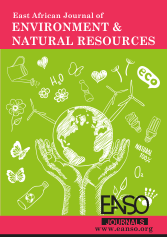The Role of Environmental Audits in Enhancing Sustainability in Industrial Property Management. Insights From Nairobi County
Abstract
Nairobi, the capital city of Kenya, is experiencing significant environmental challenges, with pollution levels reaching unprecedented heights. This issue is particularly evident in the Nairobi River Basin, which comprises the Nairobi, Ngong, and Mathare Rivers. The basin is a focal point of concern due to the widespread discharge of untreated industrial waste into its waters. The city's high population density, coupled with the concentration of industries, exacerbates the environmental impact, making Nairobi the most affected region in the country in terms of pollution. Among the various sources, industrial pollution emerges as a major contributor, prompting the National Environmental Management Authority (NEMA) to intervene and hold accountable the industries responsible for these environmental violations. This study set out to analyze the role of environmental audits in the management of industrial properties, focusing on a case study of industrial properties in Nairobi. The research targeted three key industrial areas: Nairobi Industrial Area, Baba Ndogo, and the industries along Nairobi-Mombasa Road. The study's target population consisted of 487 respondents, comprising 440 property managers and 47 NEMA County directors. Using Yamane’s 1967 formula, the sample size was determined to be 211 respondents. The study employed a simple random sampling method for data collection, utilizing questionnaires and interviews to gather information. Data analysis was conducted using descriptive statistics with SPSS version 24, and interpretation was guided by a theoretical framework and previous research. The study found that environmental audits significantly enhance industrial performance by improving organizational effectiveness, ensuring regulatory compliance, and boosting competitive advantage. They also raise awareness of environmental impacts, enhance corporate reputation, and provide valuable data for investors. However, challenges such as corruption, regulatory bias, and high audit costs persist. The research underscores the importance of environmental management and recommends that property managers strategically implement audit systems to support sustainable industrial growth and regulatory compliance
Downloads
References
Constitution of Kenya (2010). Environment and Natural Resources; Article 69. National Council of Law Reporting, Kenya
Crowther, D., & Aras, G. (2014). Corporate Social Responsibility. Güler Aras & Ventus.
Distress for Rent Act (2012). Right of Distress. Chapter 293. National Council of Law Reporting, Kenya
Dunlap, N., Geagea, N. P., Gjerde, R., & Kirk, N. J. (2018). Principles of Real Estate Management. Chicago: The Institute of Real Estate Management.
Environmental Management and Coordination Act (1999). Environmental Audit and Monitoring. Chapter 387. National Council of Law Reporting, Kenya
Jayne, N. (2000). Development and Trends in Environmental Auditing. International Journal of Auditing, 4 (3), 247-268
Kelly, P. G. (2002). Environmental Auditing- an appraisal of existing guidance and current practice with a view to developing a standardized audit protocol. Ireland: A thesis submitted in part fulfillment of the HETAC requirements for the award of Master of Science in Environmental Protection at Institute of Technology, Sligo.
Kenya Law Reports (2012). Estate Agents Act Chapter 533. Laws of Kenya.
Kiama, A. (1995). Industrial Real Estate Management. A thesis submitted in part fulfillment for the degree of masters of Arts -housing administration. Nairobi Kenya: University of Nairobi.
Ministry of Environment and Mineral Resources. (2011). Kenya national profile to assess the chemicals management. Republic of Kenya. https://www.nema.go.ke
Ministry of Environment and Natural Resources (2003). The Environmental Impact Assessment and Audit Regulations. Government of Kenya.
Mugenda, O.M. and Mugenda, A.G. (2003). Research Methods, Quantitative and Qualitative Approaches. ACT, Nairobi.
Occupational Safety and Health Act (2007). General Duty of Persons in Control of Certain Premises in Relation to Harmful Emissions into Atmosphere. National Council of Law Reporting, Kenya
Okul, D. (2019, July 28). Review and Critique of EMCA as Kenya’s Principal tool of Environmental Governance. Retrieved from Silvica Consulting: https://silvica.site/review-and-critique-of-emca-as-kenyas-principal-tool-of-environmental-governance/
Richmond, B. (2006). Introduction to Data Analysis Handbook. Washington: Academy for Educational Development.
Ryan. (2017). Property Management. Burwood: Deakin University.
Stanwick, A., & Stanwick, D. (2001). Cut Your Risks with Environmental Auditing. Journal of Corporate Accounting & Finance. 12 (4), 11-14
Waswa, F., Ouma, K. O., & Mireri, C. (2007). Principles and Practices of Environmental Auditing in Kenya. Environment and Sustainable Development: A Guide for Higher Education in Kenya.
Yashin, S., Borisov, S., & Sukhanov, D. (2019). Environmental audit as a tool for socio-economic evaluation & security management of an industrial enterprise. E3S Web of Conferences. Russia: E3S Web of Conferences. Retrieved from https://doi.org/10.1051/e3sconf /201911002065
Olonde, J. (2022). Kenya and Its Environment. Linkedin. Retrieved from: https://www.linkedin.com/pulse/kenya-its-environment-jacob-olonde
Paribus Real Estate (2021). Property Management and Environmental Responsibility in Buildings. BNP Paribus Real Estate. Retrieved from: https://www.realestate.bnpparibas.com/property-management-and-environmental-responsibility-buildings
Xiao, C. (2013). The Nature and Bases of Environmental Concern among Chinese Citizens. Social Science Quarterly. 94 (3), 672-690
Copyright (c) 2024 Phoebe Karimi Kariuki, Phoebe Mueni Nzuki

This work is licensed under a Creative Commons Attribution 4.0 International License.




























